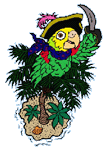 |

|
||||||||||
 |
 |
 |
 |
 |
 |
|
 |
||||
|
The Basic Care of Canaries by Terry Beaudoin Healthy, well cared for canaries are, without a doubt, the most consistently happy animals I have been around. They sing, fly about their cages, and play with their toys all day long when their basic needs are met. Their needs, as I will explain later in this article, are quite easy to meet. A male canary's song is one of the most pleasant in the entire bird world. Contrary to what many people have believed, myself included until recently, canaries can become a very interactive pet. All it takes is the patience to teach them that they do not have to fear us. Canaries are an unusual combination in a bird in that they can become interactive with people yet are not apparently adversely affected by their schedule of interaction varying dramatically. Canaries and the other finches are the birds where we make the only exceptions to our rule on feather clipping. (All the members of the parrot family should be kept clipped as they get sufficient exercise from climbing). I feel that they should have the opportunity to fly; in fact, we know that without the chance to fly their life span is dramatically shortened due to a lack of exercise. This can be achieved in one of two ways:
A canary's basic day-to-day needs as far as cleaning, feeding and watering schedule are the same as that of most other birds. *NOTE: Rather than explaining this here I refer you to my article entitled 'General Care of Pet Birds' in the General Care section of our Educational File Folder. The diet for a canary is similar to that of other finches (the dry portion of the diet we recommend for canaries is the same one we recommend for finches and parakeets). It is made up of human consumption grade seeds, fruits and vegetables, nuts, bee pollen (found by nutritional experts to be highly beneficial to birds as a source of vitamins and amino-acids) and herbs chosen for their Vitamin A content. This dried mix can make up approximately 75% of a canary's diet. The other 25% or so should be made up of fresh (preferably organic) vegetables high in Vitamin A. (We have copies available of Scott's newsletter article describing which are the best of these to use). Some fruits are also beneficial, as are breads and pastas. Tofu and well-cooked egg whites are a great source of protein. Insects are another supplementary food that many people are loath to feed - bait shops usually have euro larvae and other smaller fishing baits that work well. As I mentioned earlier until recently I was one of the people that did not think of canaries as a potentially interactive pet. Even though I had read several articles stating Canaries could be affectionate pets, it took seeing a canary owned by Shari to finally change my mind. Her bird was exceptionally responsive to her. It was even trained to enter and leave its cage on command - this is a training feat that many parrot owners cannot accomplish. Additional Species Specific articles:
|
|||
Copyright
© 2000-2003 Parrot Island, Inc.
Send mail to webmaster with
questions or comments about this web site.